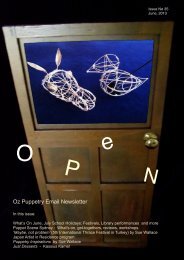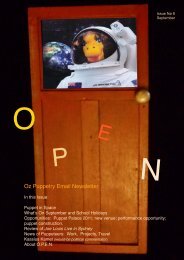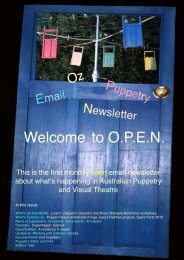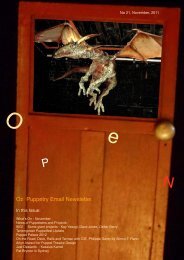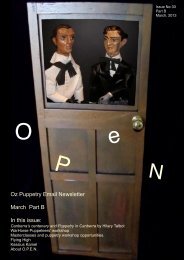P
OPEN 11 - Dream Puppets
OPEN 11 - Dream Puppets
- No tags were found...
Create successful ePaper yourself
Turn your PDF publications into a flip-book with our unique Google optimized e-Paper software.
Norman Hetherington OAM, Australiaʼs most well-known puppeteer and creator of Mr. Squiggle<br />
(which played on ABC TV for 42 years), died on December 6, after a long illness. He was aged 89.<br />
This issue of O.P.E.N. is dedicated to Norman. Many have paid tribute to him and we celebrate his<br />
life and achievements in the following pages.<br />
Norman Hetherington 1921 - 2010<br />
The following is a eulogy written and presented<br />
by Richard Bradshaw at Norman Hetheringtonʼs<br />
funeral on Monday, 13th December.<br />
I was still at school when I first met Norman. That was in<br />
1952 when I went to see a Saturday afternoon show at a<br />
small puppet theatre for children in an old army hut in<br />
Burnie Park, Clovelly. At the end of the program some<br />
adults presented a marionette version of an Aboriginal<br />
legend and one of those adults was Norman Hetherington.<br />
They were not his puppets, but he was there for some<br />
first-hand experience before he embarked on a career of<br />
puppetry.<br />
Later that year Norman turned up at a meeting of the<br />
Puppetry Guild with two marionettes he had made. They<br />
were based on traditional variety figures: a devilish<br />
contortionist and a skeleton which could fall apart and<br />
reassemble. They were stunning figures, better looking<br />
than most we had seen in books of overseas puppetry.<br />
Then in 1953 he mounted his first marionette production,<br />
“The Reluctant Dragon”, a play by Harcourt Williams. I<br />
remember it very fondly. Itʼs about a dragon who would<br />
prefer to write poetry than wage war. He is finally worked<br />
up to battle when he is accused of writing “punk poetry”.<br />
Smoke comes out of his nostrils ... or from one nostril in<br />
this case ... and this was the forerunner of lots more<br />
smoke down the years. Norman designed brilliant<br />
puppets, had a wonderful sense of fantasy, and used lots<br />
of talcum powder ... to make smoke. In later years on TV<br />
the human presenters faced the smoke from Bill<br />
Steamshovel and Rocket. Sometimes it came out in<br />
lumps.<br />
Norman felt that puppets should do what humans couldnʼt.<br />
In his 1954 production of “The Magic Tinderbox” the king<br />
was transformed before our eyes. His arms became owls,<br />
his legs became frogs, and his body became a big purple<br />
pig. You canʼt learn to do that at NIDA.<br />
One night, at a Puppetry Guild meeting in Erskineville,<br />
Norman did something quite special for us. He used his<br />
hands and bits of card to make an amusing series of<br />
shadow sketches. I particularly remember the swan,<br />
whose neck and head were his own arm and hand, and<br />
whose body was Normanʼs head. Norman had a<br />
wonderful head of thick, dark, curly hair and I remember<br />
the audienceʼs delight when the swanʼs head turned to<br />
preen the “feathers” on its back. He had to stop doing this<br />
great little show when a chisel he was using to carve a<br />
puppet slipped and cut into his forearm, seriously<br />
damaging a tendon to his thumb and requiring surgical<br />
repair Fortunately for everyone the accident did not end<br />
his puppetry career.<br />
As a boy Norman had attended Fort Street High where the<br />
Principal was horrified to learn that Norman had decided<br />
to leave school to study art. How could he possibly<br />
choose the frivolous pastime of art above the academic<br />
study of language, history and football? What future was<br />
there in that?<br />
Norman was sometimes called “Norm”, but his talents<br />
were far from those of the norm ... (that bad pun is for Bill<br />
Steamshovelʼs benefit). While he was a teenager studying<br />
art at East Sydney Tech The Bulletin published cartoons<br />
he sent them. [I hope his old school principal read The<br />
Bulletin!]<br />
During World War II Norman joined an Army Entertainment<br />
Unit. The actor Michael Pate was in the same unit and<br />
wrote a book about it. On the dust-jacket is a cartoon of<br />
the members of the unit, “The Islanders”, drawn by “Heth”,<br />
which is how Norman used to sign himself. As the<br />
obituary in the Herald mentioned, it looked a bit like a<br />
Chinese character. There are two photos of Heth in the<br />
book. In one he has a little moustache and a bowler hat<br />
and is holding up the words of “Daisy, Daisy” for a<br />
community singing session. In the other, with smock,<br />
beret and palette, he is doing one of his lightning sketches<br />
as part of a Concert Party for troops in northern<br />
Queensland.<br />
.<br />
Photo:<br />
Australian<br />
War<br />
Memorial<br />
68989<br />
These troop concerts took him north of Australia to New<br />
Guinea, Dutch New Guinea and New Britain and the<br />
lightning sketches were often of personalities in the units<br />
they played to. These were accompanied by funny ad libs<br />
from Norman and sometimes he would transform one<br />
portrait into another by adding a few lines and turning it<br />
upside down. Mr Squiggle was already on his way from<br />
the Moon!



